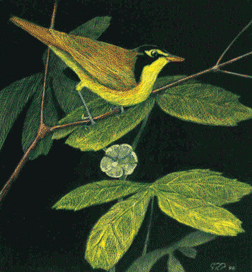|
|||||||||
Not All the Band’s HereEven so, May’s music is greatThe guitar player was late. A message on the cell phone said he was on the way. A few minutes later and we were set, our equipment in ha
nd: binoculars, camera and a bird book. For this May music session, we would be the audience. We didn’t need to see the performers, though we tried and we were partly successful. Fortunately we could hear them. The jam session was improvised: wood thrush on lead vocals with parula warbler and red-eyed vireo backing. The rhythm section was anchored by the ovenbird, with a red-bellied woodpecker on drums. High above, the chimney swifts sounded good on the castanets. A scarlet tanager made an appearance, too. They were all backed by a chorus made of dozens of their cohorts. It sounded fresh and new, even though the same songs have been performed for millions of years. It was a good show, despite the fact that some of the regular performers were missing. I always look for hooded warblers on my early May bird walks. For me it is a touchstone. They are not rare but are secretive and hard to see. On this walk, we did not hear its loud, emphatic song. Things were pretty quiet down by the swamp, too. We were greeted by a common yellow-throat, but the prothonotary warblers that usually nest there were conspicuously absent. Also missing were some of the passing-through migrants sometimes found in the area, such as the black-throated blue and green warblers. Farther down the trail I heard a Kentucky warbler, or thought I did. It is another species I look for but don’t expect to see. In most years, during my May excursions, I hear what sounds like a Kentucky lurking in dense growth near the forest floor. The song is rhythmic and rich in tone. Like most ground-oriented birds of the woods, the Kentucky’s song carries through the heavy growth. The song can be confused with that of the Carolina wren, which are common, so I hoped to see this bird in order to make a confident I.D. It has been a few years since I had been able to find a Kentucky, and I had no better luck this day. We got a nice look at a black-and-white warbler as a consolation. Not seeing the Kentucky was par for the course, but the apparent absence of hooded warblers bothered me because we were in prime habitat for this interior-forest bird. When I began birding in the 1980s, experienced birders I met then, folks who are now in their 70s and 80s, told of May mornings in earlier decades, when the birds were much more abundant. Sibleys Guide to Bird Life and Behavior says that Kentucky and hooded warblers are among those most strongly affected by deforestation in their tropical winter habitats. Loss of habitat here in the temperate zone compounds the problem. We continued down the trail, quietly contemplating what has been lost. The songs of an American redstart and finally a Louisiana water thrush helped to restore our spirits. At the end of the trail, a once-rare species that made a remarkable come back, the eastern bluebird, helped close out a fine morning. |
|||||||||
|
|||||||||
|
|
|||||||||
|
© COPYRIGHT 2008 by New Bay Enterprises, Inc. All rights reserved. |
|||||||||
 Volume 16, Issue 20 - May 15 - May 21, 2008
Volume 16, Issue 20 - May 15 - May 21, 2008
